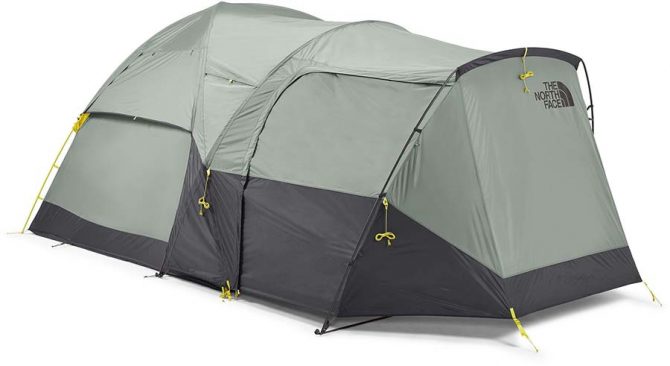
There’s nothing like camping in a tent in the woods. Photo: Nathan Lemin//The Inertia
So you want to sleep under the stars. Well, you want to sleep with a piece of mesh (and probably nylon) between you and the stars, and you’re excited to see them away from all that city light. Us too. But the tent market is rather crowded. There are endless models, colors, add-ons, material thicknesses, pack sizes, and brands to consider. Then there’s the type of tent — are you going backpacking, car camping, or something in between? What season tent do you need? These are the questions we are here to help answer. Check out our guide to the best camping tents.
Navigate To: Comparison Table | How We Tested | Buyer’s Guide
Related: Best Backpacking Tents | More Camping Gear Reviews
Editor’s Note: We updated this guide in May 2025 with a new pick, improved navigation, and refreshed links, as well as testing notes on the newest versions of tent picks. We also removed tents that were hard to find in stock.
The Best Camping Tents of 2025
Best Overall Camping Tent: The North Face Wawona 6
Runner-Up Best Overall Camping Tent: REI Co-op Base Camp 4
Best Budget Camping Tent: Coleman Sundome 6
Best Hybrid Tent: REI Co-op Half Dome 3
Best Spacious Camping Tent: REI Co-op Wonderland 6
Best Canvas Tent: White Duck Outdoors Altimus Bell Tent
Best Overall Camping Tent
The North Face Wawona 6 ($550)
Weight: 19 lbs 6.4 oz
Peak Height: 76″
Floor Area: 86.1 sq ft
Dimensions: 120″ x 96″
Packed Size: 10″ x 32″
Pros: Really big, weather resistant
Cons: Need more than one person to set up
We’ve had The North Face Wawona 6 at the top of our list for a while now, so this year we wanted to re-test the updated tent along with the 4-person version to see if they still hold up as our favorite. The short answer? Yep! But we definitely struggled to decide between the 4 and 6, ultimately settling on the 6 because of its awesome vestibule design. We love the huge extra area that you can set up to store stuff out of the elements (think chairs, coolers, shoes, etc). That said, the Wawona 4 is also an excellent option, especially when you consider it’s $100 cheaper and about 6 pounds lighter.
The North Face Wawona lineup continues its legacy of really well-made, easy-to-set-up camping tents. The livability is superb, with upright walls enabling even tall adults to stand up in the tent. The poles are color-coded to the tent clasps, and everything is clear and sturdy during setup. The tent features a good deal of mesh on the doors and upper walls, with a reliable rainfly to shed downpours (although for true weather resistance, we like the REI Base Camp below).
If you’re having trouble deciding between the Wawona 4 and Wawona 6, let us start by saying they are both excellent camping tents. Both are lighter than previous models, and just as livable and durable. Go with the 4 if you want more packability and easier setup—because it’s a touch smaller, it’s easier to set up for one person. Go with the 6 if you want the added vestibule space, a higher peak height, and overall more livability.
Check Price on REI Check Price on Backcountry
Runner-Up Best Overall Camping Tent
REI Co-op Base Camp 4 ($474)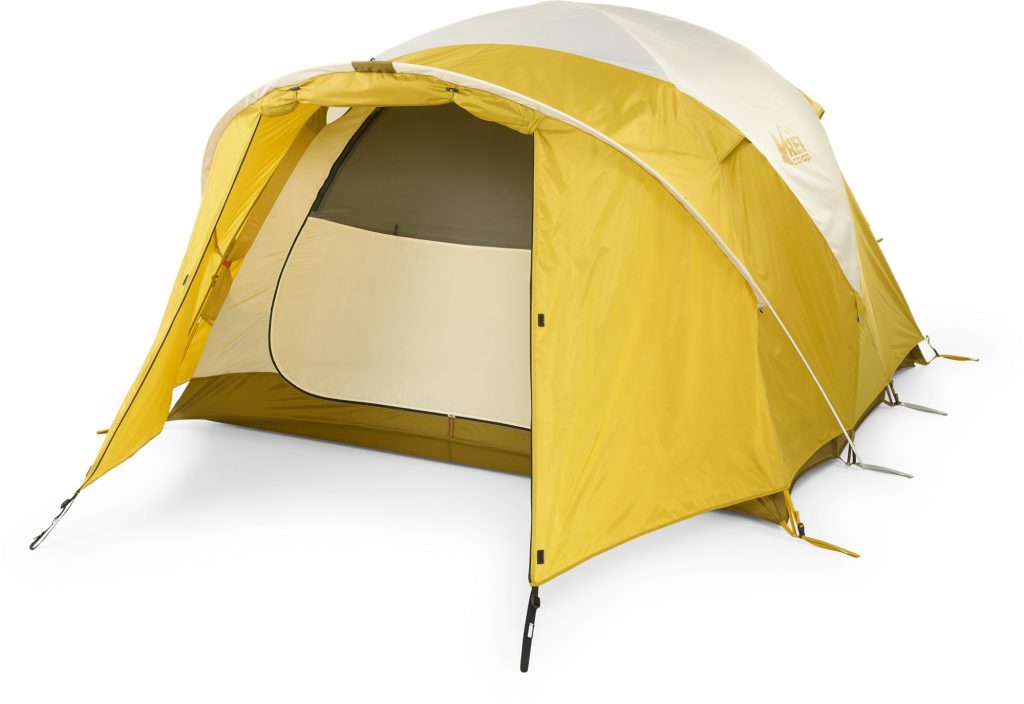
Weight: 16 lbs 14 oz
Peak Height: 60″
Floor Area: 59.7 sq ft
Dimensions: 100″ x 86″
Packed Size: 10″ x 20″
Other Versions: 6P
Pros: Can be set up alone, very weather-resistant
Cons: Tight fit for four adults
The Base Camp 4 is REI’s classic weather-resistant domed car camping tent. It can hold four adults, though with that group it’ll be pretty tight, so we’d recommend a smaller family or sizing up to the 6P version if you need more. The benefit of a slightly smaller tent is that you can set it up with a single person, and it’s more weather-resistant with a true dome design. There are two extra-large doors, and the stakeout style of the vestibules gives it ample exterior space. Plus, much like our top pick (but to a lesser extent), the extended front vestibule makes for a great all-weather area.
For a car camping tent, it’s quite comfortable, though not quite as large as the Wawona or Wonderland. The Base Camp has more of a dome design than a maximal standing-height design, which some people won’t love (but does make it a bit more resistant to wind and weather). It’s almost like an oversized backpacking tent but with car camping credo and weight. If space isn’t your main concern, it’s very comfortable. This sizable tent can be set up with a single person, and REI has locked in the pole structure. That said, the extra pole to extend the front is a little tricky, so you’ll need to try it a few times before you feel comfortable.
REI is known for providing tent pockets, and the Base Camp 4 does not disappoint. Pockets along the ground, at head height, and clips for lights make this tent excellent for organization. Add the extended vestibule up front, which doesn’t always come with car camping tents, and you’ve got yourself a mini-garage of sorts.
The Base Camp 4 takes its design queues from mountaineering tents, and while it’s not quite that weatherproof, it’s close. The materials are burly, but it’s really the dome design and excellent extra-pole feature that, when combined with guy lines, can survive strong weather. REI has a winner with this design when it comes to durable materials. That said, some online reviews reported occasional aluminum pole bends in high winds, so make sure to stake out your tent properly.
If less space and more weather-resistance fit your needs, then this, our runner-up best camping tent pick, is the best option for you.
Best Budget Camping Tent
Coleman Sundome 6 ($129)
Weight: 14 lbs
Peak Height: 72″
Floor Area: 100 sq ft
Dimensions: 10′ x 10′
Packed Size: Not Listed
Other Versions: 2P, 3P, 4P
Pros: Affordable, large, sturdy floor
Cons: Bare bones rainfly, fiberglass poles
Does a tent that costs $300 less than its competition stand up? Yes. Listen, Coleman has been doing this for nearly a century, and the Sundome 6 is a solid tent, price notwithstanding.
The Coleman Sundome has been the classic budget tent line for many years. The Coleman Sundome 6P is the largest version and is very large. You can stand up if you’re under six feet; it’s a full 100 square feet (larger than some New York apartments) and has one door for easy entry and exit. It’s definitely a budget model: fiberglass poles, a bare-bones rainfly, no vestibules, etc. That said, the floor is built of a heavy-duty tarp-like material that eliminates the need for a footprint, and there are pockets and acceptable ventilation.
Setup is not particularly difficult, but Coleman doesn’t provide the same niceties as the other brands, like color-coded poles and special grommets. But then there are no extra poles, so it’s a pretty quick process. Pockets are lacking on the Sundome 6, especially compared to the competition. They exist but won’t blow you away. And the standing room is minimal (really only in the center of the tent).
The lack of a real vestibule means rain will hit the front of your tent, and you don’t have an “outside” area that’s safe from the weather. It gets decent marks due to the tarp-like floor, which is very rugged and will keep water out. Thinner materials and fiberglass poles indicate a tent that may break sooner than you want. That said, if you’re a fair-weather camper only, it’ll survive many seasons. It’s not fancy, but it works and it’s cheap (and often on sale for less than a hundred bucks).
Check Price on Amazon Check Price on Coleman
Best Hybrid Tent
REI Co-op Half Dome 3 ($399)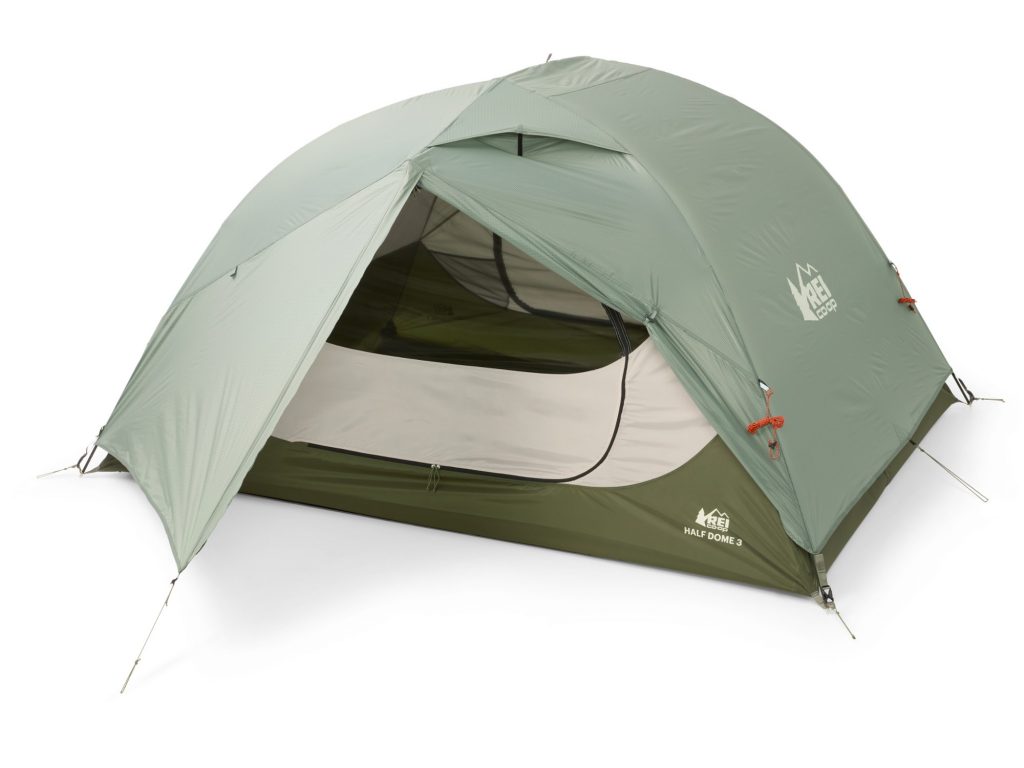
Weight: 5 lbs 11.7 oz
Peak Height: 44″
Floor Area: 48.75 sq ft
Dimensions: 90″ x 78″
Packed Size: 23″ x 7″
Vestibule Area: 22.5 sq. ft.
Other Versions: 2+
Pros: Simple design, easy setup, spacious
Cons: Doesn’t perform great in super heavy winds
As ever, with the Half Dome 3, REI hit a sweet spot on space, ease of setup, well-thought-out features, and price. Generally, if someone is asking for a versatile tent recommendation, we point them toward the Half Dome 3. It’s simple, excellent, spacious, and quite light for the specs. With each new version, REI ups the ante. Although it’s heavier, the latest feels more durable, and it can easily be pared down for backpacking (leave the footprint, stuff sack, and some stakes at home). We are impressed with both the two-person and three-person models, as well as their spacious vestibules, which enable exterior storage (and in turn more interior space). The Half Dome has all your premium features, yet plenty of space.
Large and in charge, the Half Dome 3 will feel glamorous in the backcountry. Its fully rectangular floor plan makes this tent comfortable for three adult sleepers (or two adults and three dogs, trust us, we’ve tested it). You may have trouble finding enough space to pitch it, honestly. That space, plus the roll-back fly which allows for easy star-gazing, makes for a lovely shelter. Like all hybrid/backpacking tents on this list, setup is a breeze. The Half Dome 3 has one pre-bent pole hub (no need to fiddle with multiple poles) and color coding to aid your setup.
All in all, for a one-and-done tent that boasts plenty of space for car camping adventures yet is still light and packable enough for the occasional backpacking trip, look no further than the REI Half Dome 3. Nothing beats it at this price ($399 at the time of publishing, though often marked down during REI sales).
Editor’s Note: Looking for our full list of backpacking-specific tent options? Check out our guide to the Best Backpacking Tents.
Best Spacious Camping Tent
REI Co-op Wonderland 6 Tent ($499)
Weight: 22 lbs 15 oz
Peak Height: 78″
Floor Area: 83.3 sq ft
Dimensions: 120″ x 100″
Packed Size: 32″ x 13″
Other Versions: 4P
Pros: Gigantic interior space, can stand up throughout the tent
Cons: Durability is a concern
Have a penchant for glamping? That’s okay! When you’re out in the elements all day, sometimes it’s nice to crash with creature comforts. The REI Co-op Wonderland 6 features space for you and the whole family to stretch out. This massive tent features the best headroom (78 inches!) of any on this list. And while it doesn’t have quite the same durability or ease of use as our top pick, the Wonderland 6 makes an excellent option if loads of space and standing room are a priority.
One of our testers noted that someone six feet tall could stand up comfortably nearly everywhere in this tent — a rarity for even the largest camping tents with dome structures. The Wonderland’s headroom is thanks to its unique structure: Three prominently arching pole systems create nearly vertical sidewalls. The upright structure paired with loads of mesh and huge doors makes this tent feel even bigger than it is (and trust us, it’s huge). As for floor space, we were able to comfortably fit two double sleeping pads, two camping chairs (yes, inside), two duffel bags, a dog bed, a power station, and a dirty clothes pile, all with room to walk around. And surprisingly, we were able to set up this camping tent with just one person.
As for drawbacks, there were a couple. Some reviewers on REI’s site reported issues with wind and pole damage (likely due to its upright shape). While our team experienced gusts of 15-20 miles per hour with no issue, we can’t say how the tent performs beyond those numbers. Also, the rain fly positioning has a couple of weak spots (over the side windows), so heavy rain may cause leaks. That said, for pure space and comfort, the REI Co-op Wonderland 6 is really tough to beat.
Check Price on REIBest Canvas Tent
White Duck Outdoors Altimus Bell Tent ($1,130)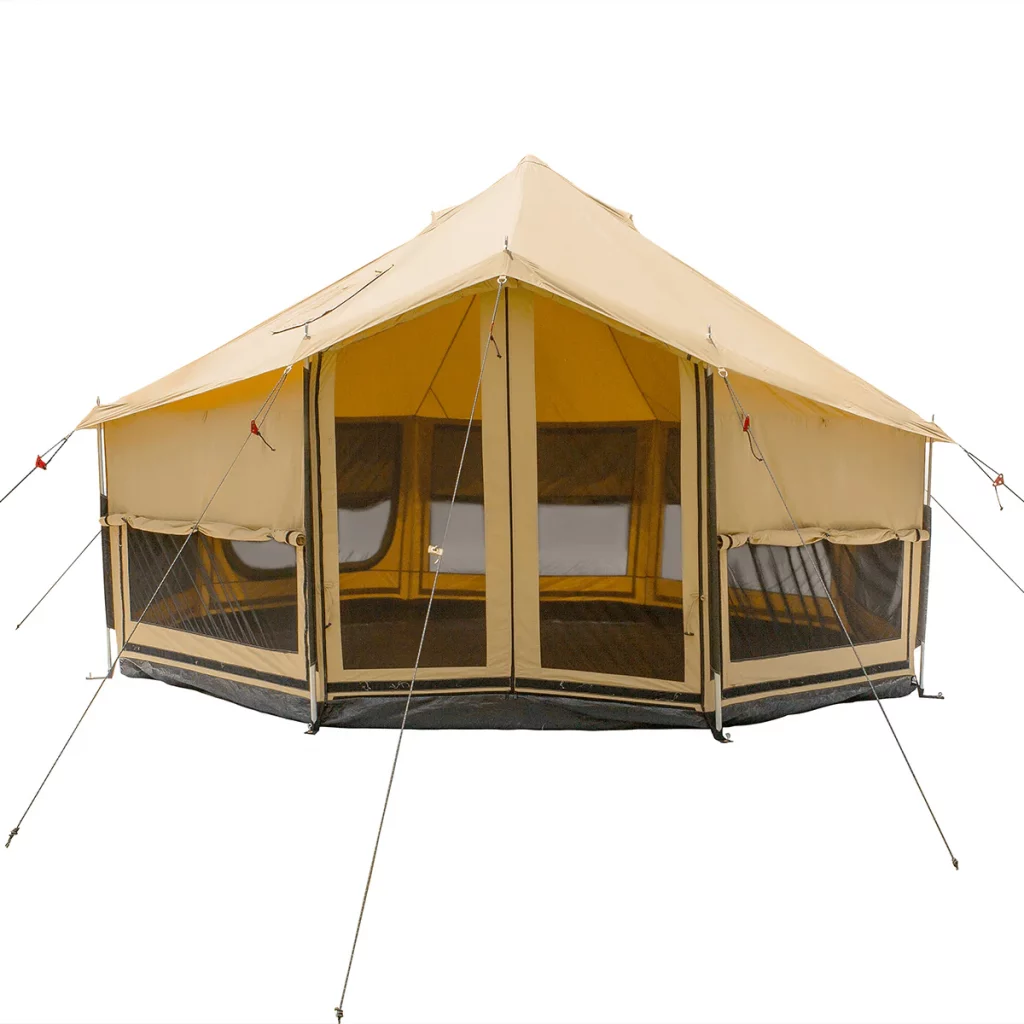
Weight: 77 lbs
Peak Height: 9’2″
Floor Area: ~150 sq ft
Dimensions: 14′ x 14′
Packed Size: 45″ x 16″ x 13″
Other Versions: 18′
Editor’s Note: The 14′ option we tested is currently OOS, but it looks like it’ll be coming back soon. Until then, the 18′ version looks even more spacious!
Looking for the most spacious, luxurious tent around? We might just have to give that award to our favorite canvas tent this year: the White Duck Outdoors Altimus Bell Tent. At a certain level, this tent doesn’t really compare to the others on this list, as it’s far pricier, larger, and heavier. But as far as the canvas tents we’ve tested, we haven’t found any that are better. The upright walls, chimney-compatible roof, full 360-degree window ventilation, and extremely durable fabric have us rethinking the whole “roughing it” thing.
Compared to other canvas tents on the market (even within White Duck’s lineup), we like the Altimus especially for its shape and windows. On a nice day, you can get a superb breeze rolling through by opening the windows all the way around. Want some privacy? Open them just a bit. We also prefer it to a cabin tent shape because the bell-shaped Altimus feels more spacious. The peak height is over nine feet, and this feels more like a permanent structure than a camping tent.
So what’s the catch? Well, of course, with a canvas tent there are some drawbacks, namely, cost and weight. At over $1000 and approaching 80 pounds, the Altimus Bell Tent is a serious investment. We recommend this for semi-permanent camping trips, glamping, hunting, and as a guest cabin option. It’s best suited to those with a truck, too, because the packed size is still quite substantial. That said, if you want one of the most livable tents money can buy, look no further.
Check Price on White DuckBest of the Rest
Runner-Up Best Hybrid Tent
NEMO Aurora 3P ($359)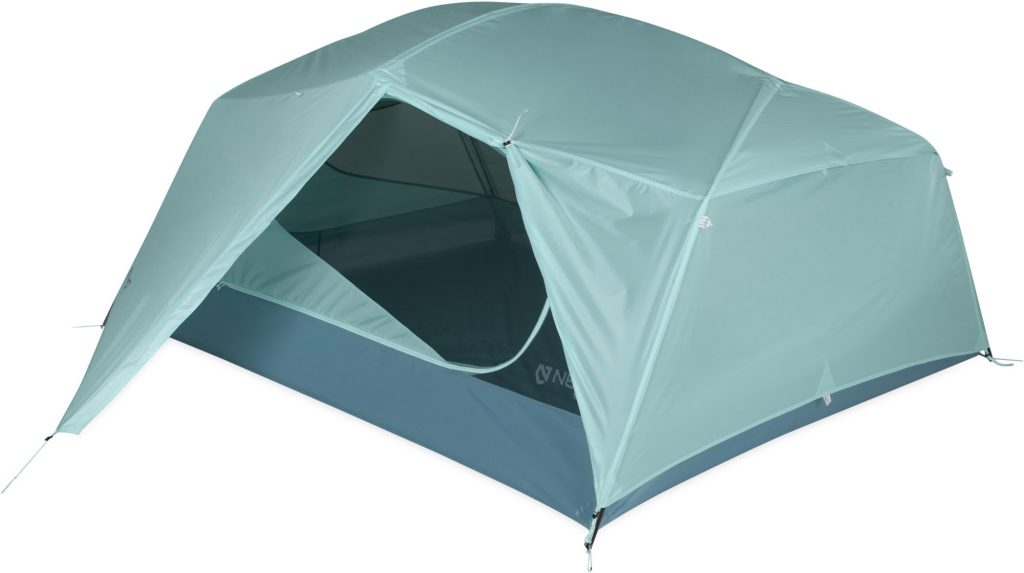
Weight: 6 lbs 14 oz
Peak Height: 44″
Floor Area: 44 sq ft
Dimensions: 88″ x 72″
Packed Size: 23″ x 7.5″
Other Versions: 2P
Pros: Easy to set up, reliable rainfly, upright wall design
Cons: Not as roomy as traditional camping tents
The Aurora 3P tent is an excellent shelter for those who want a slightly larger backpacking tent that works well for car camping too. While you won’t get the tall interior height of an extra-large camping tent or the ultralight experience of a smaller backpacking tent, you get a decent amount of space, thoughtful design, and a relatively light package (though not as light as our favorite hybrid camping tent, the Half Dome above).
The NEMO Aurora 3P boasts solid interior space, is very easy to set up with the singular aluminum pole hub, and includes a very large, very secure rainfly for inclement weather. The main feature that makes it comfortable for car camping is the upright wall design, which increases the usability and comfort of the overall interior space. Then, it has NEMO’s key tent features, like light pockets and snaps for dog-proof floors. Footprint inclusion is a nice touch, especially for a family tent. Plus, the pole hub could not be easier to set up, and the rainfly snaps on in a few minutes, a bonus regardless of camping experience.
Really, we love and highly recommend this tent. Our only reason for giving it runner-up hybrid status is for its rather heavy weight (nearly 7 pounds). That said, if you want slightly more vertical walls than the Half Dome 3, the NEMO Aurora 3P makes an awesome hybrid tent option.
If you like the upright design but want something with even more features and space for car camping, check out the Aurora Highrise.
Check Price on REI Check Price on Backcountry
Great for Sleeping In Late
Decathlon Quechua 2 Second Easy Fresh and Black 3P ($359)
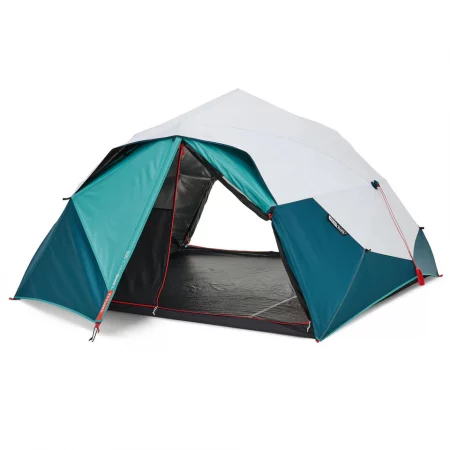
Weight: 18.1 lbs
Peak Height: 50″
Floor Area: 46.7 sq ft
Dimensions: 81″ x 83″
Packed Size: 28″ x 8.6″ x 8.6″
Other Versions: 2P
Pros: Fresh and Black technology keeps out light and (some) heat, super simple setup, 5-year warranty
Cons: Heavy, low tub floor could be an issue in heavy rains
It’s rare to see a value-oriented brand take the lead when it comes to innovation, but French outdoors-gear juggernaut Decathlon has some interesting and innovative ideas going on in their R&D department, not the least of which is their line of tents. Their tent offerings range from large family-style tents to small and light backpacking tents, with a variety of interesting technologies for easy setup and comfort.
Two such innovations are integrated into their 2 Second Easy Fresh and Black Tent. The first: pop-up technology that, while it may not take two seconds, delivers a fully set-up tent in under a minute. And the second: Decathlon’s Fresh and Black tent construction that features a white, semi-reflective tent exterior to ward off heat and a blackout interior that helps keep things dark inside when the sun comes up so you can sleep in longer.
We tested this tent at a camping festival in Bakersfield, California in early-summer conditions, and were quite impressed with just how well the tent warded off heat. While it wasn’t exactly cool inside during the heat of the day (outside temps rose above 80 degrees with little to no shade) it was certainly better than any of the other tents at the campsite. However, where this tent truly shines is during the morning. It holds in the cool morning air (and darkness) during those critical few hours when, especially after a late night at a festival or just hanging around the campfire with friends, you’d rather be asleep than tossing and turning in the heat and sunlight. It’s not going to hold that cool air for the entire day (like you might expect from the legendary ShiftPods that have become a staple at desert camping festivals like Burning Man), but for a third of the price, the bang for your buck you get with one of Decathlon’s Fresh and Black tents is hard to beat.
The only downside to this camping tent is that, although it’s billed for “camping and backpacking” the 18-pound weight of the three-person version that we tested is likely going to keep you from hauling it too far away from the car. However, for car camping, this tent fits the bill nicely. We also have yet to test this tent in the rain, but the very low tub-style floor of the tent has us a little worried about how well it will fare in truly wet conditions.
This “Fresh and Black” technology comes in a few different tent styles from Decathlon. The one we tested here is the higher-priced version, coming equipped with a door on either side of the tent, which can be used to get a nice cross-breeze going. You can also get your hands on a pop-up Fresh and Black tent for as low as $150, but you’ll be sacrificing the two-door setup.
Check Price on DecathlonMarmot Limelight 3P Tent w/ Footprint ($359)
Weight: 7 lbs 2 oz
Peak Height: 45.3″
Floor Area: 45.2 sq ft
Dimensions: 88″ x 70.1″/63.2″ head/feet
Packed Size: 6.3″ x 24.4″
Other Versions: 2P
Pros: Super spacious for hybrid tent, cool interior vestibule design
Cons: Not as taut as we’d like, door design is wonky
For a unique, spacious hybrid camping tent option, the Marmot Limelight 3P Tent is one of our favorites. While it’s a touch heavy (over 7 pounds for packaged weight), you could use it for backpacking. We think it shines brightest as a packable car camping tent, though. Its unique vestibule design creates interior wings that allow you to stash gear inside the tent for full protection (these vestibules also make great spots for dogs to curl up).
One of our editors bought the Marmot Limelight about a year ago and has since had a full testing team use it for camping on about a dozen trips. Throughout testing, we found it to be an awesome choice for couples camping with dogs, or three adult sleepers. Although the tent narrows at the feet, its super-wide design at the head (including its winged interior vestibules) doesn’t make this tent feel small or stuffy. The pre-bent poles create an upright wall design, especially near the head. And the color coding on the poles and tent makes it easy to figure out what goes where.
There are, however, two significant drawbacks to this tent (though we still like it a lot, despite these). First, the interior vestibules don’t have any pole support, so staking them out is necessary to achieve a taut and fully set-up tent. This makes them a little floppy in any wind and requires dialed-in tent staking. Second, the door design is wonky. Basically, the zippered tent door opens from the feet to the head, but the zippered rainfly door opens only near the head area. This means you have to open the rainfly door, move it fully to the side, and then access the tent door. This isn’t a total deal-breaker because a) we love to camp with the rainfly off when the weather allows, and b) this design makes the tent weather-resistant (the high walls and door design help keep out wind and rain).
Basically, we love the idea behind this Marmot Limelight 3P tent but think it could be executed even better. For a couple (especially with dogs), this makes a great hybrid camping tent option, but we’d love to see Marmot make a few refinements to improve this design even more.
Check Price on REI Check Price on Backcountry
The North Face Stormbreak 2 ($200)

Weight: 5 lbs 14 oz
Peak Height: 43″
Floor Area: 30.6 sq ft
Dimensions: 87″ x 50″
Packed Size: 7″ x 22″
Pros: Easy to set up, lantern loops, packs down small
Cons: Heavy for backpacking
The North Face Stormbreak 2 is listed as a backpacking tent, but we felt that it was better suited for camping. Weighing 5 pounds 14 ounces, the Stormbreak is a little heavy for trekking through the backcountry but makes a great hybrid option.
Setting up the Stormbreak is a breeze. The poles clip into the tent, allowing you to erect the tent in minutes. There are also other thoughtful features like a gear loop at the top for hanging a lantern and an interior pocket for stashing small essentials. While we found no particular issue with the tent, the Stormbreak can’t quite match our favorite hybrid camping tents due to its smaller interior space and less-premium feeling materials. That said, this tent from The North Face is under $200, well below the NEMO and REI options that we prefer. So, all things considered, at the price you’re getting a quality tent with the Stormbreak 2.
Check Price on REI Check Price on Backcountry
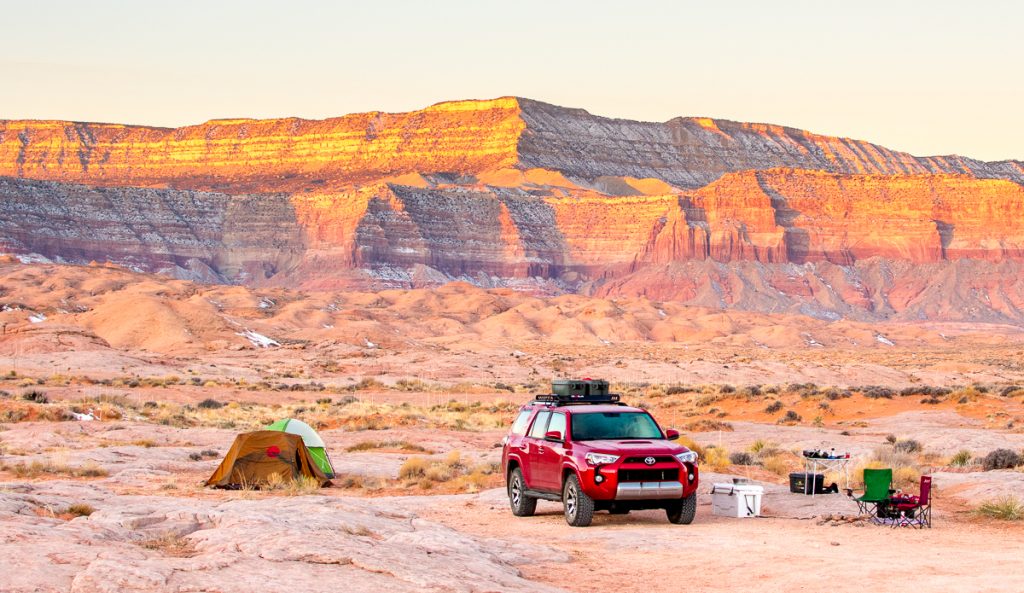
Car camping can take you pretty cool places. Photo: Nathan Lemin//The Inertia
Best Camping Tents Comparison Table
| Model | Price | Type of Tent | Height | Weight | Packed Size | Vestibule Area | Versions |
| The North Face Wawona 6 | $550 | Car Camping | 76″ | 19 lbs 6.4 oz | 10″ x 32″ | 44.7 sq. ft. | 4P, 6P, 8P |
| REI Base Camp 4 | $474 | Car Camping | 60″ | 16 lbs 14 oz | 10″ x 20″ | 27 + 17 sq. ft. | 4P, 6P |
| Coleman Sundome 6 | $129 | Car Camping | 72″ | 14 lbs | N/A | N/A | 2P, 3P, 4P, 6P |
| REI Co-op Half Dome 3 | $399 | Hybrid | 44″ | 7 lbs 2.5 oz | 23″ x 7″ | 22.5 sq. ft. | 2P, 3P |
| REI Co-op Wonderland 6 | $500 | Car Camping | 78″ | 22 lbs 15 oz | 13″ x 32″ | N/A | 4P, 6P |
| White Duck Outdoors Altimus Bell Tent | $1,130 | Semi-Permanent | 9’2″ | 77 lbs | 45″ x 16″ x 13″ | N/A | 14′, 18′ |
| NEMO Aurora 3P | $359 | Hybrid | 44″ | 6 lbs 8 oz | 23″ x 7.5″ | 23″ x 7.5″ | 2P, 3P |
| Decathlon Quechua 2 Second Easy Fresh and Black 3P | $359 | Car Camping | 50″ | 18 lbs 2 oz | 28″ x 8.7″ | N/A | 2P, 3P |
| Marmot Limelight 3P Tent | $359 | Hybrid | 45.3″ | 7 lbs 2 oz | 24.4″ x 6.3″ | N/A | 2P, 3P |
| North Face Stormbreak 2 | $200 | Hybrid | 43″ | 5 lbs 14 oz | 7″ x 22″ | 30.6 sq. ft. | 1P, 2P, 3P |
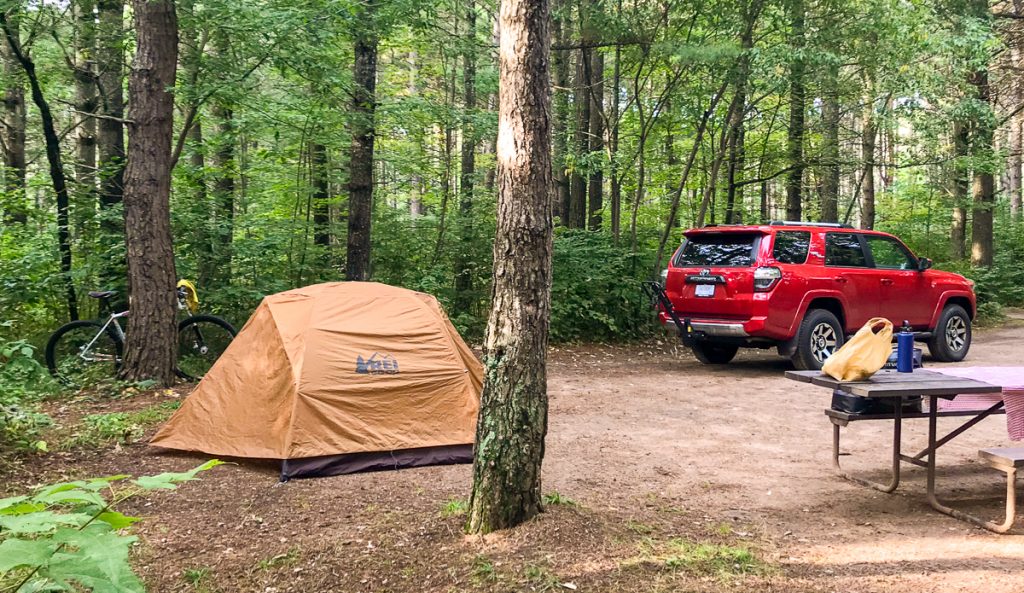
Match your tent to your needs—sometimes a small 2p tent is all you need. Photo: Nathan Lemin//The Inertia
How We Tested Camping Tents
When it comes to a guide this large that covers so much (tent-based) ground, it’s important to understand how these products fit into their respective use categories and how they were evaluated.
We describe the categories in detail below, but here’s the short and sweet of it: We split the tents up into three types: tents specific to car camping, tents built for true backpacking, and tents that can handle either category but inevitably won’t master either. For more backpacking-specific tents, refer to our full guide.
We specifically chose freestanding tents for this guide. When you get into ultralight backpacking with pole-less tents that expect you to use your own trekking poles or rooftop car camping, you end up with models that don’t really fit the standard mold for camping. A freestanding tent is standard and can be set up anywhere. Our team of experienced gear testers prefers them in all scenarios for ease of use, except in great weather on extremely ultralight adventures.

Testing the tents. Photo: Rebecca Parsons//The Inertia
To write this guide, we leaned upon the institutional knowledge of our testing staff, including Danny Zweier, Rebecca Parsons, Will Sileo, and Nathan Lemin. This team is comprised of accomplished hikers, campers, and backpackers, as well as the former editor-in-chief of a backpacking website. We got our hands on camping tents and tested them over dozens of camping trips.
We first ran this review in the spring of 2023. We updated it in May and November 2024 to correct links, expand our Buyer’s Guide, add new camping tents that we tested, and remove picks that we no longer recommend. We updated it again in May 2025 with a new pick. We removed picks that were no longer in stock or represented the best. Over the course of updating, we have also shifted some tent picks to our Best Backpacking Tents guide. We continue to test updates and new camping tents and will update this guide when we find new models that exceed the current list.

A good ultralight tent should be able to go with you deep into the backcountry. Photo: Lindsay Gough//The Inertia
Camping Tents Buyer’s Guide
Categories of Camping Tents
The first and most important question to ask: What style of tent do I need? This guide covers a wide swath of campsite styles: from large-scale family camping that includes bringing your own BBQ (BYOBBQ) to finding a flat nook next to a river in a quiet corner of the backcountry.
You don’t need the same tent for those scenarios. One requires a portable palace, the other a thin strip of fabric between you and the wilderness. There are tents built for each, and then tents that reside somewhere in the middle. We have split these categories into three main areas: Family Car Camping Tents, Backpacking Tents, and Couples Car Camping/Large Backpacking Tents (Hybrid).
Car Camping Tents
Car camping tents don’t require a family; they’re just built for large groups. It could be six college kids heading out on their first under-the-stars party weekend or the annual family campout. Car camping tents are usually made in four, six, and sometimes eight-person models (written as 4P, 6P, 8P when you buy them). They have much higher ceilings, often topping six feet, and will take up a large chunk of the campground. Our favorite is the The North Face Wawona 6 for its space, durability, and functionality.
The benefit of a family car camping tent is that everyone can sleep in one shelter: you can play games in a protected, well-lit space well into the night, and you don’t have to try to find the gear that has been spread across a messy campsite, and you have ample room to roll around. They’re also much easier to change clothes in, which might seem minor, but in a busy campground, sometimes it’s nice to have some privacy.
The downsides of such a large tent are that you won’t be alone if you’re with a group, it’s heavy and often requires two-plus people to set up, and the high ceiling can make for a less stable structure in high winds.

We got our hands on the best camping tents and put them to the test. Photo: Daniel Zweier//The Inertia
Backpacking Tents
Backpacking tents are the opposite of a family car camping tent in every way. They prioritize weight above all else because you will need to carry them for miles on your back. You’ll also need to set them up quickly, sometimes at night, and break them down the next morning as you continue on your way. Backpacking tents are made in one-to-four-person versions, though the two-person and three-person are the most popular. Ease of setup, vestibule storage space, and durability are the important tenets of a backpacking tent. For these needs, no tent provides a better combo than the REI Co-op Half Dome 3.

Hybrid tents like the Kelty Discovery Trail 2 can be used for backpacking but they’re on the large side. Photo: Rebecca Parsons//The Inertia
Hybrid Camping Tents
Finally, there are the hybrid tents, which are also called couples car camping tents or extra-large backpacking tents. We have car camped with large groups, ultralight backpacked, and taken yearly backpacking trips with all ranges of ages. It’s the hybrid tents that you see most often for most campers. And the majority of people are casual campers.
This category takes the extremes of the other two and mellows them. You get a tent that is moderately heavy but never too heavy to be carried by two or three people when you split it up. There is enough space to sleep comfortably for the recommended size, and often a bit more than necessary. These tents also usually have a decent rainfly and lower height so that they can survive any serious storms, but they can also be set up without any rainfly on a beautiful evening, so you can see the stars.
If you’re the type of person who sleeps in nature once or twice a year and wants a tent that could be taken on that random backpacking trip but also can pop up easily in most camping scenarios, this is what you want. And since most people only want to buy a single tent, this is probably your best bet. We’re huge advocates for hybrid camping tents, as we think they suit most people. Our top option is the REI Co-op Half Dome 3.

Hybrid tents are both lightweight enough for backpacking and spacious enough for camping. Photo: Nathan Lemin//The Inertia
High-End Tents vs. Budget Tents
Once you figure out what kind of tent you need, you’ll look primarily at your budget. The unfortunate reality is that a “nice tent” these days usually means an expensive tent. The quality of materials, design, and feature set is better than it has ever been, but we’d argue that the cost is higher, too.
A high-end tent for any of the categories above will start around $250, going up to $600. If those numbers make you squirm, look for a budget tent. If you’re thinking, well, my puffy jacket costs about that much, then high-end may be perfectly fine for you.
A budget tent will range from $100-$250. Anything less than $100 will be used, heavily discounted, or come from a sub-par brand. And while those tents may work, we tend to question their durability and don’t recommend them.

Setting up a tent can be easy if you choose a well-designed option. Photo: Nathan Lemin//The Inertia
Which to Choose
The big question is: do you get what you pay for? Kind of. A high-end tent will absolutely have more durable and lightweight materials, better thought-out storage and features, and more usable space than its budget counterparts. However, a budget tent will have the same basic things and will serve you decently in most of the same scenarios.
The truth is that you don’t need a high-end tent for a beautiful sunny weekend with no weather. You may prefer the brand bump for your trail neighbors, and you may love storing your sunglasses in a super special pocket right near the front, and you may exult in the lightness of your backpacking pack or the obscene space of your tent palace, but those things aren’t necessary for outdoor life: to sleep under the stars and enjoy the wild.
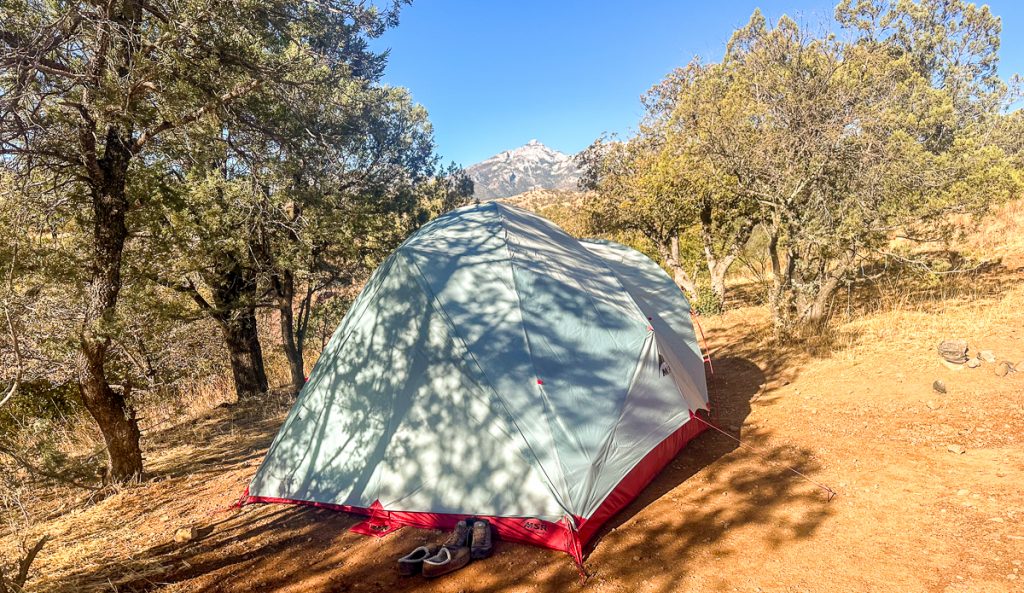
A tent with a view? We’ll take it. Photo: Nathan Lemin//The Inertia
We find that a high-end tent matters when the going gets tough. Part of interacting with the wild is that it may sometimes get downright, truly wild. Hail may find its way to you; the sky may deluge; perhaps it’ll get so swampy hot that you can barely move, or your body will fail you in some way.
For any of those reasons, having a shelter that is more durable, easier to set up, more lightweight, and has more space will make things much easier. There are plenty of stories of heavy rain leading to a soaked tent floor and therefore soaked clothing and sleeping pad, and if you couple that with near-freezing weather, you could be in trouble. If the tent had properly held out water, you might not be in that situation.
When to Buy
We always advocate for buying camping tents when they go on sale. Because tents are a costly piece of gear, try to knock off as much money as possible. Even a 20 percent sale can mean a difference of $100 or more. Also, tents aren’t updated as regularly as some other gear. Because of that, a well-made camping tent will last you for years, and you won’t have to fret about a new model coming out every year after you buy it.

Packed size and weight matter if you’re carrying your tent on your back. Photo: Daniel Zweier//The Inertia
Tent Size and Weight
We covered the philosophy of this concept when deciding what type of tent to buy, so we’re going to give some general parameters here. These are our team’s own opinions, but are heavily informed by decades of industry research and testing.
In general, size and weight are the most important aspects of any tent. The size determines how many people can sleep in a tent, and weight is critical, specifically for backpacking. Weight is not critical for car camping, though you do need to be able to fit the tent in your car. And if you ever plan to backpack (or walk away from the car) with your car camping tent, weight does matter.
Large car camping tents weigh 10-25 pounds and come in four-person, six-person, and eight-person models, with four and six being the most common.
Hybrid tents, or tents that can work for car camping as well as backpacking, weigh between 5 and 10 pounds and come in two-person, three-person, and four-person models.
Backpacking tents usually weigh less than 7 pounds and come in 1P, 2P, 3P, and 4P models.
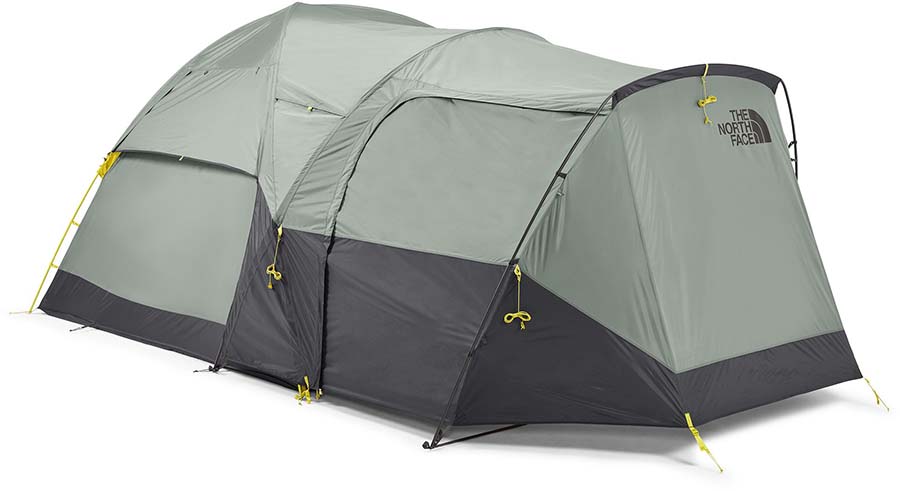
The North Face Wawona 6 is an absolutely giant camping tent. It’s got a massive 6.3-foot peak height and walls that are almost as tall, despite the dome design. It’s made with thick, durable materials, has two full doors, and a bag full of extra-large, extra-thick aluminum poles.

Even hybrid tents for backpacking and camping can pack down small. Photo: Nathan Lemin//The Inertia
How Many People Fit in a Tent?
Now, a word of warning: all tents list their size based on the number of “people” they can fit, but that number is a white lie. As in, it’s sort of true, but not all the way true. As marketers have honed in on the best way to sell a tent, it’s clear that the lowest weight and greatest space is the ideal buzzword.
Backpacking Tent Size
A two-person backpacking tent these days will technically fit two moderately fit people 6 feet or under while storing all gear in the vestibules, but they won’t fit an elbow more. When our team goes out with our dogs, we usually count the pup as a person (or at least half of a person), as far as how much space they’ll take up. So we take a 2P tent for one person and one dog, or a 3P for two people and one dog (or two smaller dogs). If we’re traveling with a partner or a child, we’re looking at a 3P tent, and it would have to be a spacious one at that.
Car Camping Tent Size
Car camping tent numbers are more honest, but then again, you’ll likely have more stuff, larger sleeping pads, and want more elbow room. Our general rule of thumb is to buy a tent one size bigger than you’ll most commonly need unless you’re fine with the squeeze. The White Duck Outdoors Altimus Bell Tent can fit a huge group of campers, but it comes with the tradeoff of excessive weight and packed size.

The REI Co-op Wonderland 6 Tent easily fits six adults plus gear. Photo: Nathan Lemin//The Inertia
What is Trail Weight and Packaged Weight?
A note on trail weight vs. packaged weight: You will see manufacturers list these two weights, with the trail being less and being sold as the real “weight” of the tent. That’s misleading, as trail weight usually refers to only the tent body, rain fly, and poles. It doesn’t include the stakes, the bags that they are carried in, any extra guy lines, or a footprint. All those things, plus the main tent, rainfly, and poles, total up to the “packaged” weight.
We think most people want to wrap their tent in a bag and will bring the stakes it comes with and a footprint if it’s there, so we find the packaged weight to be much more accurate. Trail weight is the bare minimum and also serves as a great advertisement for an even lighter tent!

A large dome is the most comfortable tent-roof style, but doesn’t do as well in the wind. Photo: DZ//The Inertia
Floor Area, Height, and Doors
Weight and size of a tent will be somewhat indicative of how big the tent is, but when you get into the details of your home-away-from-home, there are three things you’ll notice immediately: the floor area of your tent, how high the highest point is (and how steep the slope is), and how many doors your house has.
Floor Area
In the U.S., floor area is listed in square footage, just like your Zillow rental app, and you’ll want to look for overall size and ample width for the size of the sleeping pad/air mattress you have. The other critical factor in your overall tent area is the slope of your tent; if the square footage is large, but the sidewalls slope heavily immediately, you won’t be able to use much of that space unless you’re sleeping. This is fine for backpackers who only sleep in their tent, but if your idea of a campout is card games and Heads Up until the stars are bright, you will want steeper walls.

Peak height varies drastically–in a true camping tent, you may be able to stand up, but in a hybrid or backpacking tent, sitting up is typically the limit. Photo: Nathan Lemin//The Inertia
Peak Height
Peak height is a clear metric for any tent, and it means the tallest point of the tent, right in the middle. Backpacking tents hover around 40 inches, and camping tents range from 45 inches to over six feet (fully standing).
Again, the dome’s structure is important; a backpacking tent could have a decent single peak height but a very slopey design so that you don’t have much headroom overall. The best backpacking tents are those that have a decent peak height and maintain much of that height through the rest of the tent. Camping tents allow for full standing for almost any individual, but remember that taller tents tend to be more vulnerable to whipping winds. Upright camping tents like The North Face Wawona 6 and REI Co-op Wonderland 6 are designed so that you can stand up nearly anywhere inside.
Camping Tent Doors
Then there are doors; those portals of perception that lead, in this case, to the wild. And to your middle-of-the-night pee spot. Two doors are ideal, and most tents have two doors. Some car camping tents only have one door, and truly budget backpacking tents have one. This matters more for your group size and comfort level — if you’re OK with someone stepping over you in the night to pee, then maybe one door is fine.
But for most people, two doors are convenient. Usually, two doors are easier given the space, and there are two vestibules instead of one, and they provide better airflow.

The ideal tent packs down small but is spacious when set up. Photo: Rebecca Parsons//The Inertia
Camping Tent Poles
Back in the day, tent poles were a real liability. They weighed more than those cans of baked beans you hauled into the wild, threatened to snap if you pushed too hard, and could quickly become impossible to rethread if you weren’t careful.
Aluminum
These days, tent poles, especially the nice ones, are a dream. Most of the tents on this list use aluminum poles, which is the preferred middle-range material when it comes to pole construction. Aluminum allows for low weight, solid strength, excellent flexibility, and structural integrity. Sometimes aluminum can bend easily in the wrong situation, so you want to be sure to stake your tent correctly and use tension to protect against winds rather than the pole alone.
Fiberglass
Some budget tent poles still use fiberglass, which is the material of old, but they are better made than they used to be. Still, fiberglass poles do sometimes bend and splinter in heavy winds and weigh a lot more than aluminum.

High-quality DAC poles are becoming more and more common in backpacking and even hybrid tents. Photo: Nathan Lemin//The Inertia
DAC Tent Poles
Then there are DAC poles, used primarily in ultralight backpacking tents. Yes, this is a specific company, and no, they aren’t the only manufacturers of excellent ultralight tent poles, but they’re the gold standard, sort of like GORE-TEX for waterproofing. These are made with a proprietary high-strength alloy and are now in pre-bent pole hub configurations, creating optimal headroom and ease of setup. Nowadays, even more mid-range camping tents like the REI Co-op Half Dome 3 feature DAC poles.

Rainflys that buckle in are nice for easy setup but they aren’t typically as effective. Photo: Rebecca Parsons//The Inertia
Footprint and Rainfly
Footprint
Although it’s not essential, putting down a footprint or some sort of tarp can be a good idea as it can help protect your tent. The footprint is the outermost layer that will protect your tent from rocks and dirt. A footprint can also help add extra warmth and waterproofing. A few of the tents on our list came with a footprint, but most didn’t. If there isn’t an option to purchase a compatible footprint, a tarp or drop cloth works great. Remember that a footprint adds weight, so tents sold with one might seem heavier than competitors – something to factor in when deciding your weight needs. We like that the REI Co-op Half Dome 3 comes with a footprint.
Rainfly
A rainfly is an essential piece of equipment when camping. Even if you’re camping somewhere dry, it’s always a good idea to have your rainfly handy just in case. A rainfly can also trap in warm air while you’re sleeping and help keep you warmer. A few of the tents on our list had the rainfly built in, but for most of the tents, the rainfly was a separate piece of material. Some rainflys attach to the tent by simply buckling them in, whereas others must be staked out. We found that the buckles made it easy to throw on the rainfly last minute, but when your rainfly is fully spread out and staked down, it is the most effective.
Camping Tents Storage
We’ve touched on storage elements throughout, so we’ll be brief. You’re looking for vestibules with enough room to keep your extras dry and pockets with enough room to store all your little valuables that will otherwise get lost at night.

Spacious vestibules help you store your gear—from backpacks to chairs and beyond. Photo: Nathan Lemin//The Inertia
Vestibules
Two vestibules are ideal, and for backpacking tents, you need them to protect your backpack and shoes at night and maybe allow a quick boil if it’s raining during the day. We can’t stress how nice a good vestibule is: our tester has backpacked in tents that provide shallow, ill-fitting vestibules and woken up to damp shoes and soaked-through backpack lids, which is annoying. A tent with a large vestibule that provides solid, real coverage for your gear is great.
For car camping, vestibules are less common because you can store all your important goods in your car or a bear box, but they are still nice, especially if it’s raining. And some tents, like The North Face Wawona 6, have decided to upgrade the entire vestibule experience into a full-on room. You’ll see large tents do this, and it makes for a weatherproof changing, cooking, and hanging station that’s out of the wind, rain, bugs, and any other odd weather. Great for those who don’t want to experience that much nature.

Tents like The North Face Stormbreak 2 are easy to set up and tear down. Photo: Rebecca Parsons//The Inertia
Set Up and Tear Down
Most tents are straightforward to set up, but we found that some tents required that we pull out the instruction manual. Generally speaking, a simple design is preferred as it makes it easy to get things set up. Although it’s not a race, it’s nice to have a tent that goes up quickly and easily. The easiest tent to set up on our list was the Decathlon Quechua 2 Second Easy Fresh and Black 3P, which went up in about a minute. We found that poles that clipped in were much easier than poles that had to be inserted into slots. And, as we mentioned before, rainflys that clipped in with buckles were the easiest to set up, but rainflys that were staked down were the most effective.
Taking down a tent is almost always easier than setting it up, but with some tents, getting it back into the bag can be a mission. Through our testing, we found that tents that could be stuffed back into their bag instead of carefully rolled up were our favorite,e as it was much easier to get everything to fit. If your tent is challenging to get back in the bag and space isn’t an issue, you can simply store your tent in a duffel bag or garbage bag.
Editor’s Note: For more camping gear reviews, click here. Plus, check out other gear we cover. For our most recent gear reviews and features on The Inertia, click here.


